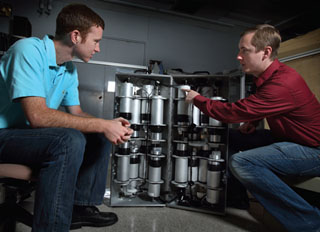
Zach Strater, a junior at St. Mary’s University in San Antonio, spent his summer evaluating neutron detectors at Sandia. He came to the Labs through a fellowship from NNSA’s National Science and Security Consortium (NSSC), a multi-institution consortium led by the University of California, Berkeley.
The consortium partners — Michigan State University; UC Davis; UC Irvine; the UC Institute on Global Conflict and Cooperation (IGCC) based in San Diego; the University of Nevada, Las Vegas; and Washington University in St. Louis — are collaborating with three DOE laboratories in addition to Sandia: Lawrence Berkeley National Laboratory (LBNL), Lawrence Livermore National Laboratory (LLNL), and Los Alamos National Laboratory (LANL). The
consortium also brought in a wider network of affiliates from minority serving institutions (MSI). Zach is the first NSSC-MSI student fellow to be placed at a national laboratory.
Zach’s work supported the Mobile Imager of Neutrons for Emergency Responders (MINER) project, which is developing a portable fast neutron scatter camera for emergency response applications. Mark Gerling (8132), one of the designers of MINER, served as Zach’s mentor.
Thermal neutron systems based on Helium-3 are frequently the detectors of choice when searching for special nuclear material. Helium-3 detectors are very efficient for measuring the gross neutron count rate, but because they slow down the neutrons to thermal energy to detect them, most of the information about the neutrons is lost.
MINER uses multiple liquid scintillator (LS) cells coupled to photomultiplier tubes and is sensitive to neutrons in an energy range characteristic of a fission spectrum. The data acquisition of MINER captures and analyzes the time-dependent output of each photomultiplier tube to determine if each pulse of light in the LS cell resulted from a gamma ray or neutron interaction. The sum of all neutron-like interactions from the 16 LS cells is the gross neutron count rate that can be compared to the Helium-3 backpack detection system. MINER, however, can also analyze the data from all LS cells to look for signatures that would be characteristic of a single neutron interaction in two different LS cells (i.e., a double scatter event). By analyzing the data associated with these double-scatter events, both a low resolution image and energy spectrum of the emitting source of neutrons can be created. This additional information is not available with Helium-3 backpack detectors.
“We are often asked how MINER compares to a Helium-3 detector,” says Craig Tewell (8132), manager of the Rad/Nuc Detection Systems group. “Zach has spent his summer working on that comparison.” So far, says Zach, the data for MINER looks promising.
The summer has had a big impact on Zach — he’s now considering graduate school. “Before I came here,
I had no interest in graduate school,” he says. “But now I’m seriously considering a PhD because I now see how it opens up so many different options and allows you to become quite specialized within a field.”
Sandia is involved in two additional NNSC projects. UC Berkeley graduate student Patricia Schuster is working with both LLNL and Sandia on an NSSC-funded project to understand the anisotropic light emission from crystalline organic scintillators. Mark Allendorf (8600) and Patrick Doty (8131) also received an NSSC grant to work with Clark University professor Conrad Ingram on advanced materials radiation detection.
The goal of NSSC is to support the nation’s nuclear nonproliferation mission by focusing on the hands-on training of undergraduate and graduate students in the fields of nuclear physics, nuclear and radiation chemistry, nuclear engineering, nuclear instrumentation, and public policy. Sandia played a role in helping UC Berkeley win the proposal to lead NSSC through its connections with the university’s nuclear engineering department. (Lab News 8/12/2011)